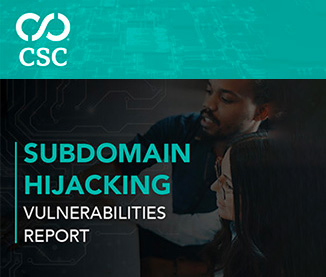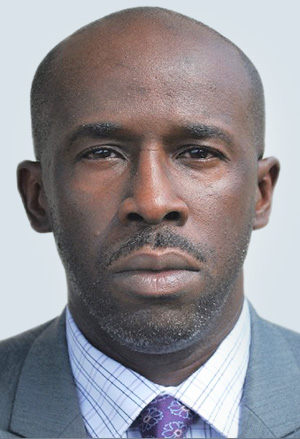

Brand Protection |
Sponsored by |

|



 Unsuspecting website visitors are often unaware when they have landed on a spoofed page or are re-directed to malware-hosting web servers designed to steal their sensitive data and information. This attack is known as subdomain hijacking, or subdomain takeover. A web user's private information is then traded on the dark web, and cybercriminals profit, further fueling the expansion of identity theft in the online world. more
Unsuspecting website visitors are often unaware when they have landed on a spoofed page or are re-directed to malware-hosting web servers designed to steal their sensitive data and information. This attack is known as subdomain hijacking, or subdomain takeover. A web user's private information is then traded on the dark web, and cybercriminals profit, further fueling the expansion of identity theft in the online world. more
 The legal status of domain names is one of the most hotly debated topics with regards to evolving property rights and how they should be applied to technological and intellectual property 'innovations' in cyberspace. At present, there are two opposing factions on this topic: On one hand, there are those who maintain that domain names should be considered as contracts for services, which originate from the contractual agreement between the registrant and the registrar. more
The legal status of domain names is one of the most hotly debated topics with regards to evolving property rights and how they should be applied to technological and intellectual property 'innovations' in cyberspace. At present, there are two opposing factions on this topic: On one hand, there are those who maintain that domain names should be considered as contracts for services, which originate from the contractual agreement between the registrant and the registrar. more
 The OECD held a "high-level" meeting in June 2011 that was intended to build upon the OECD Ministerial on The Future of the Internet Economy held in Seoul, Korea in June 2008. I was invited to attend this meeting as part of the delegation from the Internet Technical Advisory Committee (ITAC), and here I'd like to share my impressions of this meeting. This 2 day meeting, "The Internet Economy: Generating Innovation and Growth", had the objective of exploring a number of current issues in the public policy space... more
The OECD held a "high-level" meeting in June 2011 that was intended to build upon the OECD Ministerial on The Future of the Internet Economy held in Seoul, Korea in June 2008. I was invited to attend this meeting as part of the delegation from the Internet Technical Advisory Committee (ITAC), and here I'd like to share my impressions of this meeting. This 2 day meeting, "The Internet Economy: Generating Innovation and Growth", had the objective of exploring a number of current issues in the public policy space... more
 Phishing scams are nothing new in the online security world and show no signs of subsiding. The scam starts when a fraudster sends a communication purporting to originate from a trusted provider and encourages the recipient, often with a conveyed sense of urgency, to click a link. That link leads to a fake site, usually intended to collect confidential login credentials or other personal information. In similar scams, the mail may encourage the recipient to open an attachment loaded with malicious content. more
Phishing scams are nothing new in the online security world and show no signs of subsiding. The scam starts when a fraudster sends a communication purporting to originate from a trusted provider and encourages the recipient, often with a conveyed sense of urgency, to click a link. That link leads to a fake site, usually intended to collect confidential login credentials or other personal information. In similar scams, the mail may encourage the recipient to open an attachment loaded with malicious content. more
 The ICANN Board has approved the community recommendation that "the provision of Thick Whois services should become a requirement for all gTLD registries, both existing and future." We have long supported the migration from 'thin' to 'thick' Whois, which will improve both quality and ease of access to Whois data, thereby further facilitating intellectual property enforcement online. The ICANN community has debated the merits of migration from 'thin' to 'thick' Whois for years, as part of the larger Whois Review process. more
The ICANN Board has approved the community recommendation that "the provision of Thick Whois services should become a requirement for all gTLD registries, both existing and future." We have long supported the migration from 'thin' to 'thick' Whois, which will improve both quality and ease of access to Whois data, thereby further facilitating intellectual property enforcement online. The ICANN community has debated the merits of migration from 'thin' to 'thick' Whois for years, as part of the larger Whois Review process. more
A group of 83 Internet inventors and prominent engineers sent an open letter today to the members of the United States Congress, stating their opposition to the SOPA and PIPA Internet blacklist bills that are under consideration in the House and Senate respectively. more
 In the first article of this two-part blog series, we looked at how frequently domains were used by bad actors for phishing activity across individual top-level domains (TLDs) or domain extensions, using data from CSC's Fraud Protection services, powered by our DomainSecSM platform. In this second article, we analyze multiple datasets to determine the highest-threat TLDs, based on the frequency with which the domains are used egregiously for a range of cybercrimes. more
In the first article of this two-part blog series, we looked at how frequently domains were used by bad actors for phishing activity across individual top-level domains (TLDs) or domain extensions, using data from CSC's Fraud Protection services, powered by our DomainSecSM platform. In this second article, we analyze multiple datasets to determine the highest-threat TLDs, based on the frequency with which the domains are used egregiously for a range of cybercrimes. more
According to the latest report from The World Intellectual Property Organization (WIPO), trademark owners filed 2,754 cases under the Uniform Domain Name Dispute Resolution Policy (UDRP) with the agency in 2015 - an increase of 4.6 % over the previous year. more
 A domain name consists of two main elements: the second-level domain name to the left of the dot - often consisting of a brand name or relevant keywords - and the domain extension or top-level domain (TLD) to the right of the dot. Domain names form the key elements of the readable web addresses allowing users to access pages on the internet and also allowing the construction of email addresses. more
A domain name consists of two main elements: the second-level domain name to the left of the dot - often consisting of a brand name or relevant keywords - and the domain extension or top-level domain (TLD) to the right of the dot. Domain names form the key elements of the readable web addresses allowing users to access pages on the internet and also allowing the construction of email addresses. more
 There has been a lot of back and forth recently in the ICANN world on what constitutes domain abuse; how it should be identified and reported AND how it should be addressed. On one side of the camp, we have people advocating for taking down a domain that has any hint of misbehaviour about it, and on the other side we have those that still feel Registries and Registrars have no responsibility towards a clean domain space. (Although that side of the camp is in steady decline and moving toward the middle ground). more
There has been a lot of back and forth recently in the ICANN world on what constitutes domain abuse; how it should be identified and reported AND how it should be addressed. On one side of the camp, we have people advocating for taking down a domain that has any hint of misbehaviour about it, and on the other side we have those that still feel Registries and Registrars have no responsibility towards a clean domain space. (Although that side of the camp is in steady decline and moving toward the middle ground). more
 As the brand protection industry approaches a quarter of a century in age, following the founding of pioneers Envisional and MarkMonitor in 1999, I present an overview of some of the main outstanding issues which are frequently unaddressed or are generally only partially solved by brand protection service providers. I term these the 'Millennium Problems' in reference to the set of unsolved mathematical problems published in 2000 by the Clay Mathematics Institute, and for which significant prizes were offered for solutions. more
As the brand protection industry approaches a quarter of a century in age, following the founding of pioneers Envisional and MarkMonitor in 1999, I present an overview of some of the main outstanding issues which are frequently unaddressed or are generally only partially solved by brand protection service providers. I term these the 'Millennium Problems' in reference to the set of unsolved mathematical problems published in 2000 by the Clay Mathematics Institute, and for which significant prizes were offered for solutions. more
 .tk was once designated as the riskiest ccTLD. .ru is often said to be, after .com, the most used in the content of spam messages. But is there a ccTLD that is a favorite destination for copyright infringement? The question is worth asking in view of the growing trend for .com domain names seizures related to copyright infringement. more
.tk was once designated as the riskiest ccTLD. .ru is often said to be, after .com, the most used in the content of spam messages. But is there a ccTLD that is a favorite destination for copyright infringement? The question is worth asking in view of the growing trend for .com domain names seizures related to copyright infringement. more
 With the same made-for PR timing that prompted a previous seizure of domain names just before shopping's "Cyber Monday," Immigration and Customs Enforcement struck again, this time days before the Super Bowl, against "10 websites that illegally streamed live sporting telecasts and pay-per-view events over the Internet." ICE executed seizure warrants against the 10 by demanding that registries redirect nameserver requests for the domains to 74.81.170.110, where a colorful "This domain name has been seized by ICE" graphic is displayed. more
With the same made-for PR timing that prompted a previous seizure of domain names just before shopping's "Cyber Monday," Immigration and Customs Enforcement struck again, this time days before the Super Bowl, against "10 websites that illegally streamed live sporting telecasts and pay-per-view events over the Internet." ICE executed seizure warrants against the 10 by demanding that registries redirect nameserver requests for the domains to 74.81.170.110, where a colorful "This domain name has been seized by ICE" graphic is displayed. more
 A recent news story, following research from security provider Infoblox, highlighted the case of the 'Revolver Rabbit' cybercriminal gang, who have registered more than half-a-million domains to be used for the distribution of information-stealing malware. The gang make use of automated algorithms to register their domains, but unlike the long, pseudo-random ('high entropy') domain names frequently associated with such tools, the Revolver Rabbit domains instead tend to consist of hyphen-separated dictionary words (presumably so as to obfuscate their true purpose), with a string of digits at the end. more
A recent news story, following research from security provider Infoblox, highlighted the case of the 'Revolver Rabbit' cybercriminal gang, who have registered more than half-a-million domains to be used for the distribution of information-stealing malware. The gang make use of automated algorithms to register their domains, but unlike the long, pseudo-random ('high entropy') domain names frequently associated with such tools, the Revolver Rabbit domains instead tend to consist of hyphen-separated dictionary words (presumably so as to obfuscate their true purpose), with a string of digits at the end. more
 If a national government wants to prevent certain kinds of Internet communication inside its borders, the costs can be extreme and success will never be more than partial. VPN and tunnel technologies will keep improving as long as there is demand, and filtering or blocking out every such technology will be a never-ending game of one-upmanship. Everyone knows and will always know that determined Internet users will find a way to get to what they want, but sometimes the symbolic message is more important than the operational results. more
If a national government wants to prevent certain kinds of Internet communication inside its borders, the costs can be extreme and success will never be more than partial. VPN and tunnel technologies will keep improving as long as there is demand, and filtering or blocking out every such technology will be a never-ending game of one-upmanship. Everyone knows and will always know that determined Internet users will find a way to get to what they want, but sometimes the symbolic message is more important than the operational results. more